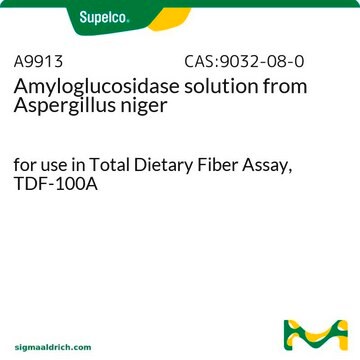A3306
α-Amylase, heat-stable
solution, for use in Total Dietary Fiber Assay, TDF-100A
Synonym(s):
α-Amylase from Bacillus licheniformis, Heat-Stable Alpha-Amylase, Heat-stable enzyme, 1,4-α-D-Glucan-glucanohydrolase
Select a Size
Select a Size
About This Item
Recommended Products
biological source
bacterial (Bacillus sp.)
Quality Level
form
solution
quality
for use in Total Dietary Fiber Assay, TDF-100A
specific activity
20000—60000 U/mL
greener alternative product characteristics
Waste Prevention
Design for Energy Efficiency
Learn more about the Principles of Green Chemistry.
sustainability
Greener Alternative Product
technique(s)
activity assay: suitable
suitability
suitable for hydrolysis, synthesis of oligosaccharides and polysaccharides, and sugar modification
application(s)
food and beverages
Looking for similar products? Visit Product Comparison Guide
Related Categories
General description
Application
- as part of the animal feed in the experimental design to study the effect of dietary fiber on reproductive performance of sows during gestation
- as a supplement to prepare simulated small intestinal fluid (SSIF) and validate the in vitro digestibility by comparing with endogenous small intestinal fluid (ESIF) on different feeds in ducks
- to perform an in vitro intestinal digestion using raspberry dietary fiber
Biochem/physiol Actions
Other Notes
related product
signalword
Danger
hcodes
pcodes
Hazard Classifications
Resp. Sens. 1
Storage Class
11 - Combustible Solids
wgk_germany
WGK 3
ppe
dust mask type N95 (US), Eyeshields, Faceshields, Gloves
Choose from one of the most recent versions:
Certificates of Analysis (COA)
Don't see the Right Version?
If you require a particular version, you can look up a specific certificate by the Lot or Batch number.
Already Own This Product?
Find documentation for the products that you have recently purchased in the Document Library.
Customers Also Viewed
Our team of scientists has experience in all areas of research including Life Science, Material Science, Chemical Synthesis, Chromatography, Analytical and many others.
Contact Technical Service











